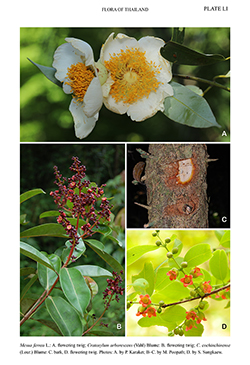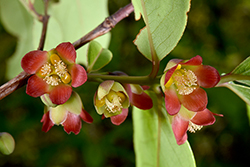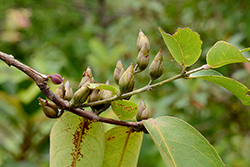e-Flora of Thailand
Volume 14 > Part 3 > Year 2019 > Page 483 > Hypericaceae > Cratoxylum
2. Cratoxylum cochinchinense (Lour.) Blumewfo-0000625754
Mus. Bot. 2: 17. 1852; Corner, Gard. Bull. Straits Settlem. 10: 26–27, 34. 1939; Smythies, Comm. Sarawak Trees: 69. 1965; Gogelein, Blumea 15: 463. 1967; N.Robson in Fl. Males., Ser. I, Spermat. 8: 4–6. 1974; Corner, Wayside Trees of Malaya 1: 325. 1988; P.H.Hô, Ill. Fl. Vietnam 1(1): 579, f. 1604 1991; Thin, Sida 17: 742. 1997; S.Gardner et al., Field Guide Forest Trees N. Thailand: 49. 2000; H.W.Li et al., Fl. China 13: 36–37. 2007— Hypericum cochinchinense Lour., Fl. Cochinch. 2: 472. 1790.— Vismia cochinchinensis (Lour.) Spreng., Syst. Veg. (ed. 16) 3: 350. 1826. Plate LI: C–D.
Accepted Name : This is currently accepted.
Synonyms & Citations :
Description : Trees or shrubs 2–30 m tall; dbh 35 cm; outer bark deeply fissured, yellow at cambium, sapwood white, heartwood brown, hard; exudate reddish-brown; branchlets terete, smooth, light brown to dark brown, slender, delicate, scars present. Leaves petioled, 0.2–0.5 cm long; oblong to elliptic, 2.9–12.1 by 1–4.7 cm, base cuneate to attenuate, apex rounded, acuminate or acute, smooth and delicate to papyraceous or coriaceous, shiny, dark tan/red to light yellow/green, sometimes glaucous, black dots present on upper surface, density of black dots varying with each leaf, midrib faint on both surfaces, more visible on lower surface, narrowing approximately 1/2 mm towards apex, light green to red/brown, secondary, intersecondary, tertiary and intramarginal veins visible on both surfaces, more obvious on lower surface, secondary veins not arising at same points on either side of midrib.Inflorescence axis flattened, flowers on leafy twigs in axils of mature leaves (usually 2 per leaf pair), some also in terminal clusters, 1–5 flowered; pedicels 0.1–0.2 cm long. Sepals oval, obovate, 5–7 by 2–5 mm, obtuse, dull green to dark purple. Petals 5–10 by 2.5–5 mm, red, crimson, pink or orange, with longitudinal veins. Stamens 45–55 per fascicle, 4–8 mm long, sometimes congested. Ovary 2–3 mm long; style 1–3 mm long. Seeds (5–)6–8 per locule, oblanceolate, elliptic or oblong, 6–8 by 2–3 mm.
Thailand : NORTHERN: Chiang Mai, Chiang Rai, Lamphun, Phrae, Sukhothai, Phitsanulok, Kamphaeng Phet; NORTH-EASTERN: Loei, Sakon Nakhon, Nakhon Phanom, Khon Kaen; EASTERN: Nakhon Ratchasima, Surin, Ubon Ratchathani; SOUTH-WESTERN: Uthai Thani, Kanchanaburi, Ratchaburi, Phetchaburi, Prachuap Khiri Khan; CENTRAL: Saraburi, Nakhon Nayok; SOUTH-EASTERN: Sa Kaeo, Prachin Buri, Chon Buri, Rayong, Chanthaburi, Trat; PENINSULAR: Chumphon, Ranong, Surat Thani, Phangnga, Phuket, Krabi, Nakhon Si Thammarat, Phatthalung, Trang, Satun, Songkhla, Pattani, Yala, Narathiwat.
Distribution : Myanmar, China, Indochina, Malay Peninsula, Borneo, the Philippines, Sumatra.
Ecology : Evergreen, deciduous or tropical rainforests, grassy area, scrub, from near sea level to 1,100 m alt. Flowering: March–June; fruiting: August.
Vernacular : Tio (ติ้ว)(Ratchaburi); taeo (แต้ว), taraet khi tai (ตาแรดขี้ไต้)(Trat); tio kliang (ติ้วเกลี้ยง)(Chiang Mai).



